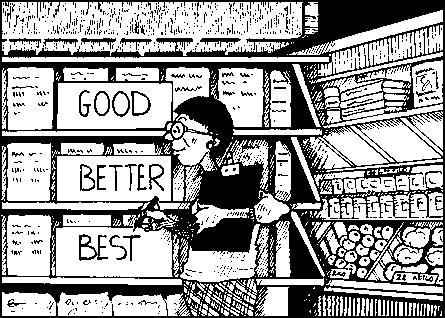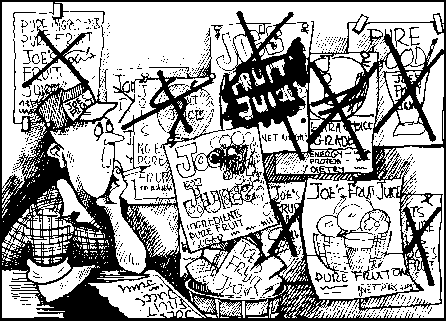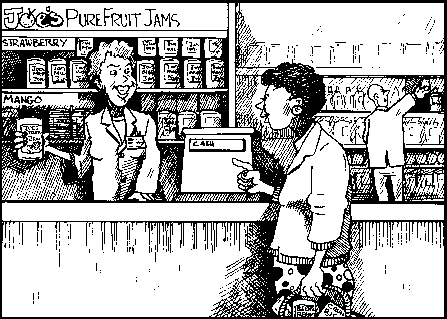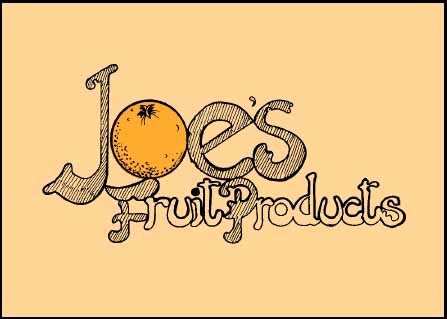Main points in Chapter 4
How can your product
be made attractive to consumers?
A product can taste wonderful but few people will buy
it if it is too expensive, in the wrong packaging or unsuitable sizes, or if the
labels are unattractive or uninformative.
This stage of the
market research process involves ...
checking on the size units and prices of competing products, according to location;
identifying quality weaknesses of the competition;
examining the containers used for competing products, in relation to the types of containers you can supply;
learning from the labelling used by competitors and finding out legal obligations regarding label contents;
considering the use of a brand name.
It is important to understand the quality of competing products, and where your product fits into the quality range.

FURTHER INFORMATION REQUIRED
Your research has confirmed that there is a good market for the type of product you plan to make, and you feel you should have no trouble selling what you produce. When you test your product on potential consumers they seem to like it. However, before you can be sure that your new business will be a success there are a lot more questions that require answers. The first question is: “even if people like the product, will they buy it when it is in the shops?” To answer this you need to look at the following:
can you compete on price with other products?
can you compete on quality?
what sizes are sold on the market?
what packaging and containers do shopkeepers and consumers want and can you supply these?
what labels are needed and what information do you need to put on the labels to both satisfy consumers and satisfy the law?
are you going to give your product a “brand name?”
Price competition
Figure 3 gives an example of a survey form which could be used to compile basic information about products available in a region, their sizes and their prices. Using such a form you can obtain a lot of information, which can be checked with shopkeepers. Also, if you do not understand the reasons for some of the answers this research gives you, you can ask shopkeepers if they can explain. For example, you may find that one shop stocks only small sizes while another sells only large containers. The shopkeepers may explain that this is because one shop is close to a school and mainly sells drinks or snacks to schoolchildren, while the other shop mainly sells family packs.
|
MARKET RESEARCH HINT You can get a considerable amount of information by looking at the shelves of the shops you visit for interviews. Advance research of this type will make you appear knowledgeable when meeting with shopkeepers and this may improve the quality of information you get from them. Also, there is no purpose in wasting the time of shopkeepers by asking them questions that you can answer for yourself by spending a little time looking at their shelves. Look out for the sizes and prices of competing products, and the packaging and labels used. You need to be aware of the way in which other suppliers are distributing their products. For example, as we noted in Chapter 2, some high-quality products may only be available in shops serving richer areas. |
Figure 3
Example of a price survey
form
|
Product |
Village shop 1 |
Supermarket |
Village shop 2 |
Town shop |
Suburban shop |
|
ABC Orange |
$1.30 |
$1.20 |
$1.40 |
$1.25 |
n.a. |
|
ABC Orange |
$0.40 |
$0.35 |
$0.45 |
$0.40 |
n.a. |
|
Joe’s Fresh Orange |
n.a. |
$3.30 |
n.a. |
$3.60 |
$3.75 |
|
Joe’s Fresh Orange |
n.a. |
$1.75 |
n.a. |
$1.90 |
$1.95 |
|
Jane’s Orange |
n.a. |
$1.25 |
$1.40 |
n.a. |
$1.30 |
|
Jane’s Orange |
n.a. |
$0.35 |
$0.45 |
$0.45 |
$0.40 |
n.a. = not available
As noted in Chapter 3, it would be useful, when testing your product with consumers, to give them a similar product to taste at the same time, not telling them which one is yours. This will give you an idea both of what consumers think about your product and how they compare it with other products already available. If, for example, the tasting test shows that consumers think yours tastes best or is better in any other way, then you may be able to price it near the top of the price range, although you may need to charge lower prices at the beginning to encourage people to try your product (see Chapter 8 for comments on pricing techniques). But however good your product is, and however much it costs to make, you will only be able to charge what people are prepared to pay for it. If your product is clearly better than any other similar product, don’t make the mistake of thinking that you can charge much more for it. Most consumers have only limited amounts of money to spend on non-essential items and, even if they recognize the quality of your product, will probably not want to, nor be able to, pay much extra for it.
If the processed product you plan to produce is not being sold in your area then you need to look at the prices of similar products. Again, avoid thinking that you can charge much more because yours is a superior product. For example, if you are planning to produce cassava chips then the price you can charge for those will be closely related to the price of potato chips and you need to survey shops to find out the prices of potato chips and similar snack foods.
Once you have an idea of the prices at which competing products are sold, you then need to find out from shopkeepers how much of that price the producer or importer receives, and how much the shopkeeper keeps (the “margin”). Try to get as much information about this as possible as pricing arrangements will almost certainly vary from store to store and, possibly, from brand to brand. Factors influencing the shopkeeper’s margin are discussed in Chapter 5.
After you have found out from shopkeepers how much they are paying other suppliers, you need to ask two very important questions. These are:
1. “If I wanted to sell my product to you for X dollars,[9] how much would you sell it for in your shop(s)?”
and
2. “If I wanted you to sell my product for Y dollars, how much would you pay me?”
This information is very important to help you work out whether you can run a profitable business (see Chapter 8). If you need to sell your product for X dollars to make a profit, you have to be sure that people will want to buy it at the price the shops will charge. Don’t assume that the shop will want to apply the same mark-up to your product as it does to other brands. The shopkeeper may feel that he or she already stocks sufficient brands of that product and will only agree to stock yours in return for a larger mark-up. This may push the retail price up above the price of Y dollars that similar products are selling for. If you want your product to sell in shops for Y dollars then you may have to sell it to shops for prices less than those you require to make a profit (see also, “Pricing, margins and mark-ups” in Chapter 5).
Competing on quality
Shopkeepers, particularly those running larger shops, usually have a good idea of what their customers want in terms of quality. Customers will not hesitate to tell them if they do not like a product and will sometimes ask them to stock a different brand that they have purchased elsewhere. Ask shopkeepers what they think of the quality of the products they are selling and whether there is a gap in their range that you could supply. For example, village shops may tell you that they only sell concentrated orange juice because juice in cartons or plastic bottles is too expensive for their customers. They may suggest that they could certainly sell juice in bottles if it were not too expensive. Shopkeepers in urban suburbs may say that customers complain about the quality of the juice they sell and they could sell fresh juice if someone produced it.
You should also ask shopkeepers about the relationship between price and quality. Which of their existing brands sells best? Is this because the price is low, because the product is seen as offering good value for money, or both? If you plan to sell your product at the same price as this popular brand then you may have problems.
Sizes available on the market
It is very important that you fully research the size units competing products are being sold in. You will probably have to sell your products in similar units because:
that is what people are used to buying;
packaging is usually only available for those sizes and it is extremely costly to ask a packaging manufacturer to produce an unusual size just for your business. Only the largest companies can afford to do this.
As we noted earlier, processed foods are often sold in two or three sizes. A small size may be used for individual purchases, when people want to consume the product when they are away from home, and a large size is sold for use in the home. Snack foods, sweets or candies, juices, yoghurts, and ice cream are examples of this. The smaller the pack, the higher is the cost of packaging and handling per unit of product. Thus the retail price per litre of a small pack of fruit juice will almost always be more than the retail price per litre of a large container. Where two different sizes are available you will have to find out from the shops their interest in stocking a new brand of both sizes. A shop may feel that it could sell extra quantities of the small size but not the large size, for example.
Some types of packaging may give agroprocessors the opportunity to vary the weights inside. A snack food bag may normally be used for 50 g of the product, but there is often room to increase this to 60 g or even 70 g. Similarly, it could be possible to reduce the contents to 40 g.
|
MARKET RESEARCH HINT Other companies may change the sizes they provide at any time. Such changes are often done in order to avoid putting the price up. For example, a company may sell 50 g chocolate bars for 50 cents. At this price it may have trouble making a profit and want to put the price up to 55 cents. However, if it puts the price up:
As a short-term alternative, the manufacturer may decide to reduce the size of the chocolate bar to 45 g. Few customers are likely to notice and the price remains the same while giving the manufacturer more profit. This practice is sometimes followed even when customers are certain to notice. For example, in order to keep the price of a pack of cigarettes in a vending machine unchanged, manufacturers have been known to take one or two cigarettes out of each pack. |
However, if you vary the contents of a package, you need to pay attention to the following:
if the package is half empty consumers will probably feel that they are being cheated. If your competitors use smaller bags but fill them up, consumers will almost certainly buy their product, even if the weight of the contents is exactly the same. Manufacturers are very conscious of not wanting to appear to be cheating consumers. Where a product is likely to settle down in the box or container after being packed (corn flakes for example) it is common for the manufacturers to put a note on the packet such as “box may not be full due to settling”;
every time you change the weight of the contents you will have to reprint the label to indicate the new weight.
Type and quality of packaging and containers
Your packaging will have to protect and preserve the product. Beyond that, your decision about what type of packaging to use should be based on research among consumers, retailers and wholesalers, as well as on what type of packaging is available to you. If, for example, you are proposing to compete with imported products that use sophisticated packaging you may find that such packaging is not available in your country and that it would be prohibitively expensive to import. Will retailers be prepared to sell your product with less-sophisticated packaging? Will consumers want to buy it? Try to find out why particular types of containers or packages are used. For example, if clear glass jars or bottles are used, is this because people like to see the product? Would you have trouble selling your product if it was in dark glass, which is normally only used for products that need protecting from the light?
You need to check on the different types of containers that are used and discuss with retailers the types of packaging they prefer and the reasons why. Retailers may want items that can be easily stacked on their shelves and may thus prefer biscuits or snack foods in boxes rather than bags.
Packaging serves three basic functions:
Product protection. Packaging protects a product by maximizing its shelf life. Detailed information on this topic is available elsewhere.[10]
Packaging can protect products from the following types of problem:
Handling and transporting the product. While many products are still transported and sold unpacked, there is an increasing trend for packaging to be used. This is partly to provide greater protection, for the reasons outlined above, but it is also to provide greater convenience in handling, both for the shopkeeper and the consumer. The growth of supermarkets has been an important factor: supermarkets reduce costs by having relatively few staff and relying on the customers to serve themselves. This requires that most products are sold in packages. In Europe in 1960 it was still common for biscuits, for example, to be sold loose. That has died out and in Europe only a few processed products, such as dried fruits, are now occasionally sold in loose form.
Promotion and information. Packaging can be printed or it can have labels fixed to it. Attractive packaging will make people interested in your products. Boring packaging with handwritten or badly printed labels will make it very difficult to sell the products. The type of packaging used can also be an important selling point. A good-quality container suggests that the contents are of high quality. Poor-quality packaging suggests that the contents are not particularly good, even if that is not the case. Indeed, poor-quality packaging is a common cause of business failure. You have, of course, to decide whether the additional cost of using high-quality packaging, and the higher prices you have to charge, will be compensated for by increased sales.
When visiting shops you need to look closely at the packaging used by your competitors or potential competitors. One of the important things to consider is the “sell-by” date that processors are increasingly putting on their products and which, in some countries, is already a legal requirement. This is used to reassure consumers that they are not buying old stock. It also protects the manufacturer should retailers sell old stock that has safety or quality problems. In such a situation the manufacturer can deny responsibility because the product was sold after its “sell-by” date.
The duration of the “sell-by” date is also very important for retailers. They will usually prefer to stock the brand that has the longest shelf life as this reduces the risk of not being able to sell a product before it passes its “sell-by” date. If your competitors’ products have a shelf life of three months you need to use a manufacturing process and packaging that can support a similar shelf life. Alternatively, the retailer may want you to take back any products that cannot be sold before the “sell-by” date.
Labelling
The label you fix to a can, bottle or bag, or the printing you put on a bag or box is extremely important. It is not something that can be planned and done at the last moment. It has to be considered from the beginning and as part of your market research activities you need to research the way in which labels are used. The functions of a label or printed package are to:
Persuade the buyer. Your label needs to make the consumer want to buy your product. If you are competing with other brands of the same product you will have a hard time persuading consumers to try yours, unless they are dissatisfied with the brands already available. You need to look closely at the labels of existing brands in the shops. It would be useful to give examples of competitors’ labels to the person who designs your label.
Inform the customer. Labels can be used to provide information. Firstly, you have to give people an accurate description of what is inside the packaging. For example, if you are selling fruit yoghurts you will need different labels for each type of fruit you are using. Some information, such as the weight or volume of the contents and a complete list of ingredients, is likely to be a legal requirement and you need to contact the relevant government department to find out what is required. Information on nutritional content is becoming mandatory in some countries. Even if it is not a legal requirement to do so, it is a good idea to provide information on the ingredients.
Before designing a label it is important to find out what information should go on it.

An attractive label design featuring a panel of information for the customer.

Note that the label provides detailed information about the ingredients
Assist the retailer. In developed countries it is virtually impossible to market a product these days without using a bar code. This code, which is either incorporated in the label or affixed to the side of the package, is used by supermarkets to simplify the check-out process and to assist with stock control (it tells them how many of each item they have sold, so they know when to reorder). Depending on your country you may find that if you want to sell through supermarkets you also need to provide a bar code.[11]
Provide advice on using the product. Consumers may need to be told how to use products that are not particularly well known (e.g. different herbs or spices). Manufacturers often include recipes on packets in order to encourage people to experiment with new ways of using their products.
Brand name
Even if you are a very small producer you should give your product a brand name. A simple label with the word “Jam” will not be very helpful in the long term. If people like your jam they will want to buy it again. To do this, they need to be able ask the shopkeeper for it. Trying to buy jam by saying “well, the label was white and it had the word Jam written on it and it was in a jar and it really tasted good with lots of strawberries....” may work if the consumer goes back to the same shop, but will be useless anywhere else. It’s far easier if the consumer can ask for the product by name, for example, “do you have Joe’s Strawberry Jam?”
Furthermore, if you are producing a wide range of items, people who are impressed with your jam may want to try your other products. You need to have a brand name so that people will know, for example, that the mango juice they see in a shop is made by the same processor who makes great jam. This recognition will be helped further if your labels are all designed in the same way. You could put a picture on the label and use an attractive design for the brand name.
People who like one of your products are likely to try others as well...


... a distinctive brand name and label will help to identify them.
REACHING CONCLUSIONS
The market research outlined in this chapter should have enabled you to answer a number of important questions about the market, such as:
the price at which you need to sell your products in order to compete with other brands already on the market;
the importance of price and quality in different locations;
the different sizes in which other brands are sold, and in which you will probably have to sell you products;
packaging requirements and the packaging used by other brands with which you will compete.
Following this and earlier research you should be able to reach some basic conclusions about how to present your product to the market, such as:
price is very important with jam purchases and people will not be willing to pay more for my jam than other brands. Based on the present market prices, the maximum retail price for my jam should be $1.00;
most yoghurt sales are in small pots. I had been planning to sell my yoghurt in family-size pots but this will really limit my potential sales;
all snack foods on the market are imported. The quality of the packaging is better than I can buy locally but if I import my packaging it would be too expensive. I need to do some trials to see what consumers think of the packaging that is available.
By now you should have a good idea of the structure of the market and how your products could fit in. The next stage is to work out how to distribute them.
|
[9] The $ sign and the word
“dollar” are used throughout this guide to refer to money in general,
and not to any particular national currency. [10] see, for example, Fellows, P.J. and Axtell, B., “Appropriate food packaging”. (full details in “Further reading.”) [11] Information about national organizations administering bar codes can be obtained from EAN International at: http://www.ean-int.org/index800.html |